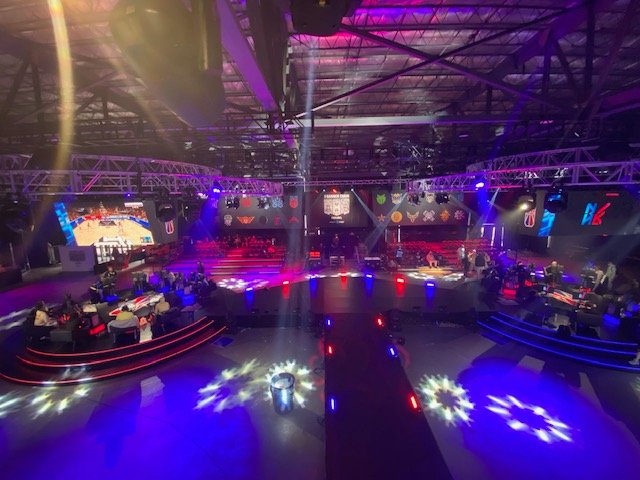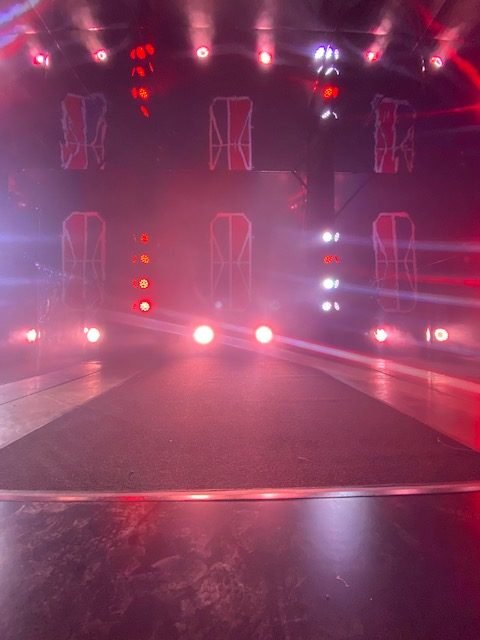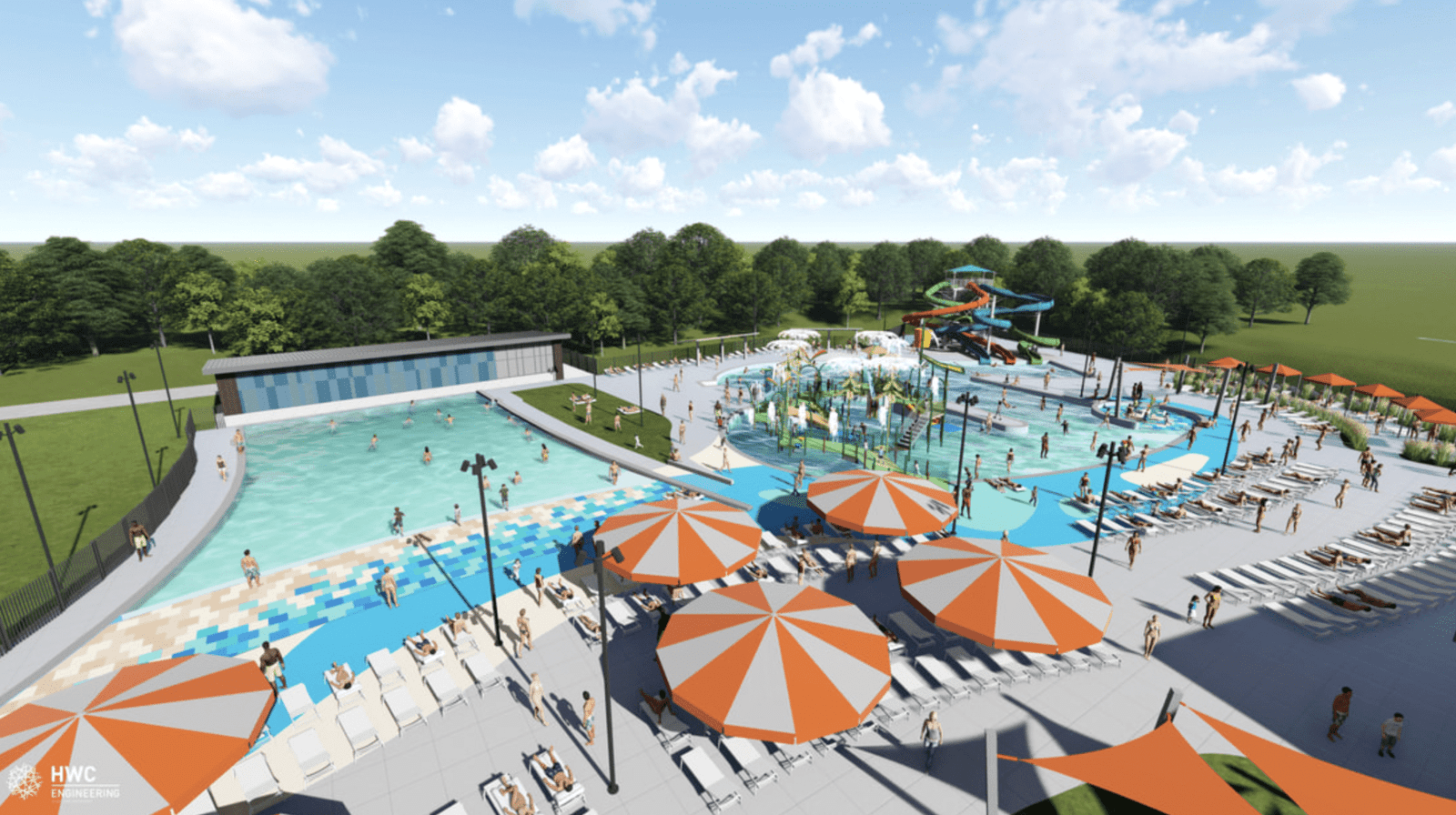The focus going forward will be on tournament play, including new 3v3 tourney
After two years of online play and remote production, the NBA2K League has a new in-person home for the 2022 season. In-person NBA 2K League competitions, which began last night with bracket play of THE TIPOFF Powered by AT&T, will take place at the new NBA 2K League Studio at The Pavilion at Pan Am in Indianapolis. And, while the league is proud of all the technology innovations and remote-production workflows it developed over the past two years, there’s nothing quite like returning to in-person LAN competitions.
“For the crew, the league, and the players, on a scale of one to 10, I would put the excitement level at about 4 million,” says Matt Arden, head of content and media, NBA 2K League. “At our live events, the energy is palpable, with all the noise and the chaos and the fun. The energy level that the players infuse into that live product is amazing, and seeing them explode and blossom on the live stage has been one of the great joys of this job. We can’t wait to have that energy back in the room and yell and scream and watch these players do what they do best.”
Although bracket play for the league’s in-season tournaments — The Tipoff, The Turn, The Ticket — and its playoffs and finals will take place in Indianapolis, NBA 2K will continue to embrace the cloud-based remote-production ecosystem it has cultivated over the past two years for qualifying and group play.
“I’m excited to finally and fully return to in-person production,” says TJ Canty, director, broadcast operations and events, NBA 2K League. “We’re still very much moving forward with our cloud-based remote-control room. There is nothing like the feel and energy of a live event. This year will be even more interesting, considering we’re doubling our overall camera counts and videoboards.”
Inside the Indy Studio: Dual Stages, Double the Cameras, Plenty of Excitement
During the pandemic, NBA 2K’s online-play broadcasts featured a fast-paced whip-around among multiple games. In an effort to recapture that high-speed excitement for LAN play, NBA 2K League experimented with the concept of dual competition stages at the 2021 Playoffs at the Mavs Gaming Hub in Dallas.
“One thing we took away from Dallas was that excitement and chaos can live in the same place,” says Arden. “Frankly, it’s very hard to cover two stages. From a live perspective, the audience is seeing what’s happening, and they can easily follow it, but to bring that through on the broadcast is a lot more challenging. Our talent has to be really on their toes, as do our camera ops, TD, and director because we are making these massive pivots midstream during the broadcast.”

NBA 2K League’s new studio features two competition stages.
The dual stages proved to be a big hit with fans and players alike and will now be a permanent feature at the new NBA 2K League Studio in Indianapolis. Two circular competition stages will host simultaneous in-person games, allowing the production team to switch between games in real time to capture the most exciting moments.
“Our main goal was to make the two stages feel like equal main stages rather than one being the side stage,” says Arden. “We tried to create a feeling of oneness between the two. Then we surrounded both with more LED [displays] than we’ve ever had before to really make it pop.”
Arden and his team worked closely with Brian Mirakian senior principal/brand activation director, Populous, and his crew to create a venue that would not only dazzle fans in attendance but also make the players themselves feel like genuine superstars. In addition to the two LED-heavy circular stages, the league has erected an LED-fueled tunnel that will be the central focus during dramatic player introductions before each competition. The casters will call the action perched atop this tunnel, creating a fresh new dynamic.
“I would describe the general vibe as part NBA arena, part Rucker Park,” says Arden. “We took a lot of inspiration from WWE as well as what the NBA did in the bubble in terms of using LED in smaller spaces to create more excitement. So we wanted big screens, lots of noise, and to make sure the players are featured prominently. We wanted to create an epic entrance for them so that, when they take their seats, they feel like superstars.”
In addition to the main competition studio, the facility features a players lounge upstairs, along with player practice rooms that double as remote game-play rooms for the 10 teams that are living in-market in Indianapolis this season.
NBA 2K League has re-teamed with its longtime production partner Defacto Entertainment and facilities provider Dome Productions for the 2022 season. Arden and his team produce each broadcast from a Dome Productions mobile unit outside the facility.

An increase in LED displays marks NBA 2K League’s new studio.
Double the stages means double the cameras, so Canty and his team have rolled out twice as many Marshall POV playercams and more handhelds (some wired, some RF) than ever to cover the action.
“We have only a few seconds to provide the viewer with full context as to why we’re making the shift [to a different stage] and what’s happening in the other game before that moment disappears,” says Arden. “It means a lot of mental gymnastics for our core talent and production staff. Being ready to pivot at any given moment for nine hours is a real challenge.”
New Season, New Structure: Going Tournament-Centric, Launching 3v3 Tourneys
The studio in Indianapolis isn’t the only big change this year. The league made significant changes to its schedule and is debuting several features for its fifth season.
First off, the NBA 2K League has pivoted from a traditional “regular season” to a format focused on tournament play (including qualifying events for tournaments), with the season spanning April through August.
“The [tournament-centric structure] has changed our narrative structure and the way we think about the telling stories during the season,” says Arden. “The new structure also means that we have a lot more this year in terms of volume. Last year, we did 52 live broadcasts; this year, we’ll do 71 between the beginning of April and the end of August — plus four days of rehearsal. We’ll be a functioning live-production unit for 75 days over the next six months.”

The ambiance is designed to spur excitement and make the players feel like superstars.
In addition to its standard 5v5 competition, the league has partnered with Coinbase to host three new 3v3 tournaments culminating with the 3v3 championship. NBA 2K League teams — comprising five players this season — will be represented by three of their players during these 3v3 tournaments. Amateur teams from around the world will also have the opportunity to participate alongside NBA 2K League teams for a share of the 3v3 tournament prize pool.
“That change from 5v5 to 3v3 has a major impact on studio ops because we have to reduce the number of chairs, which reduces the scale of our footprint depending on which tournament session we’re in,” says Arden. “We had to take that into account when building out the studio. But we were able to figure it out, and 3v3 is going to be a big addition for us. We think those amateur and pro-am [competitions] are going to serve as a conduit into our league and open windows for lots of new players and personalities.”
Even With New Studio, Remote-Production Workflow Is Here To Stay
The NBA 2K League was among the first to rebound after the pandemic arrived in March 2020, getting online competition up and running in a matter of weeks. Over the ensuing two years, the league, along with Defacto and Dome, developed a cloud-based remote workflow that will continue to be an integral part of its operations moving forward.
“Of course, we’re all excited about returning to [the studio],” says Arden, “but remote production is definitely here to stay. Remote production allows us to create one-off events, tournaments, and play-in opportunities on a much more global scale. I think this hybrid remote/live [model] will be our future. This is a great year to put rubber to road and see what we can do as this hybrid model comes to life.”
For all remote-play productions, Arden and narrative/production leadership will be based in the New York City area (either at home or at the NBA’s headquarters reopened New York office). Meanwhile, the primary production team is based in a control room at Defacto’s facility in Vancouver, and a limited crew is at Dome’s Toronto broadcast facility, which distributes the final live stream.
“We like the ratio we have this season of being 70% remote and 30% live [in-person],” says Arden. “We are in a really exciting place and where we hoped to be a couple of years ago [prior to the pandemic]. At the same time, I think the understanding of remote production has taken us to the next level and is going to make us more global this season, next season, and beyond that.”


















